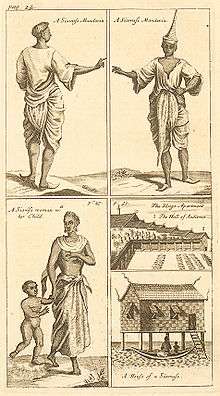Simon de la Loubère

Du Royaume de Siam.
Illustration from the English edition (1693).
Simon de la Loubère (21 April 1642 – 26 March 1729) was a French diplomat, writer, mathematician and poet.
Mission to Siam
Simon de la Loubère led an embassy to Siam (modern Thailand) in 1687 (the "La Loubère-Céberet mission").[1] The embassy, composed of five warships, arrived in Bangkok in October 1687 and was received by Ok-khun Chamnan. de la Loubère returned to France on board the Gaillard on 3 January 1688, accompanied by the Jesuit Guy Tachard, and a Siamese embassy led by Ok-khun Chamnan.[2]
Upon his return, de la Loubère made a precise description of his travels, as he had been requested by Louis XIV, published under the title Du Royaume de Siam:
"It was by the orders, which I had the honours to receive from the King upon leaving for my voyage to Siam, that I observed in that country, as exactly as possible, all that appeared to be the most singular."— Du Royaume de Siam, Simon de la Loubère.[3]
French career

De la Loubère was elected member of the Académie française (1693–1729), where he received Seat 16, following the 1691 publication of his book Du Royaume de Siam.[4]
De la Loubère was a friend of the German scientist Gottfried Leibniz, and once wrote that he had "no greater joy than (to discuss) philosophy and mathematics" with him (22 January 1681 correspondence).[5]
Magic square
De la Loubère also brought to France from his Siamese travels a very simple method for creating n-odd magic squares, known as the "Siamese method" or the "de la Loubère method",[6][7][8] which apparently was initially brought from Surat, India by another Frenchman by the name of M. Vincent, who was sailing on the return ship with de la Loubère.[9]
Siamese parachute
Simon de la Loubère is also famous for making one of the earliest account of a parachute following his embassy to Siam. He reported in his 1691 book that a man would jump from a high place with two large umbrellas to entertain the king of Siam, landing into trees, rooftops, and sometimes rivers.[10][11][12]
Works
- Du Royaume de Siam, 1691 Full text in French or Thai translation
- Traité de l'origine des jeux floraux de Toulouse (1715)
- De la Résolution des équations, ou de l'Extraction de leurs racines, 1732 Full text
See also
References
- ↑ Smithies, p.2
- ↑ Smithies, p.3
- ↑ Distant Lands and Diverse Cultures: The French Experience in Asia, 1600-1700 By Glenn Joseph Ames, Ronald S. Love Page 181
- ↑ Smithies, p.59
- ↑ Distant Lands and Diverse Cultures: The French Experience in Asia, 1600-1700 By Glenn Joseph Ames, Ronald S. Love, Page 194
- ↑ Mathematical Circles Squared" By Phillip E. Johnson, Howard Whitley Eves, p.22
- ↑ CRC Concise Encyclopedia of Mathematics By Eric W. Weisstein, Page 1839
- ↑ The Zen of Magic Squares, Circles, and Stars By Clifford A. Pickover Page 38
- ↑ A new historical relation, Tome II, p.228
- ↑ Parachuting: The Skydiver's Handbook Dan Poynter, Mike Turoff p.86
- ↑ Encyclopedia of military technology and innovation Stephen Bull p.200
- ↑ A system of aeronautics John Wise p.57
Further reading
- Smithies, Michael (1999), A Siamese embassy lost in Africa 1686, Silkworm Books, Bangkok, ISBN 974-7100-95-9
| ||||||
|